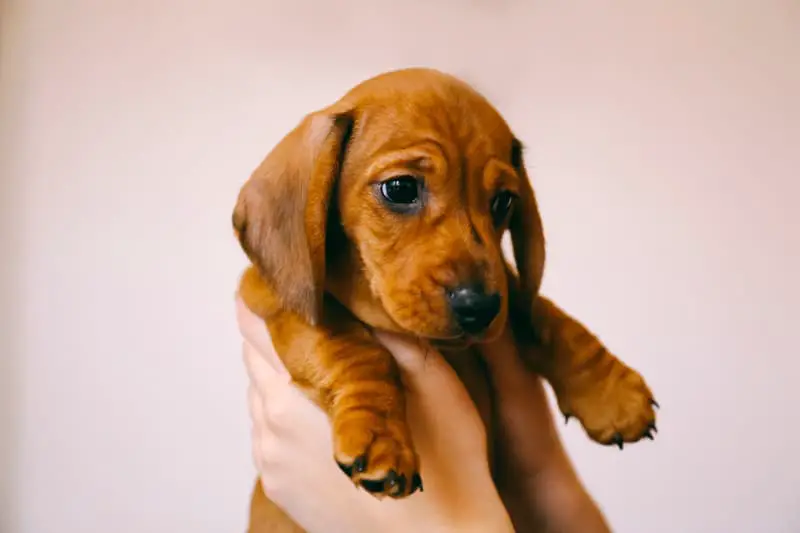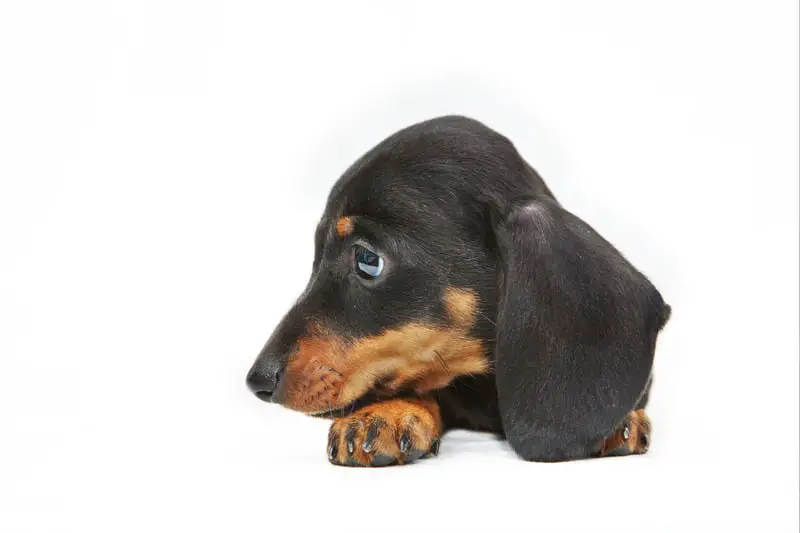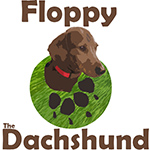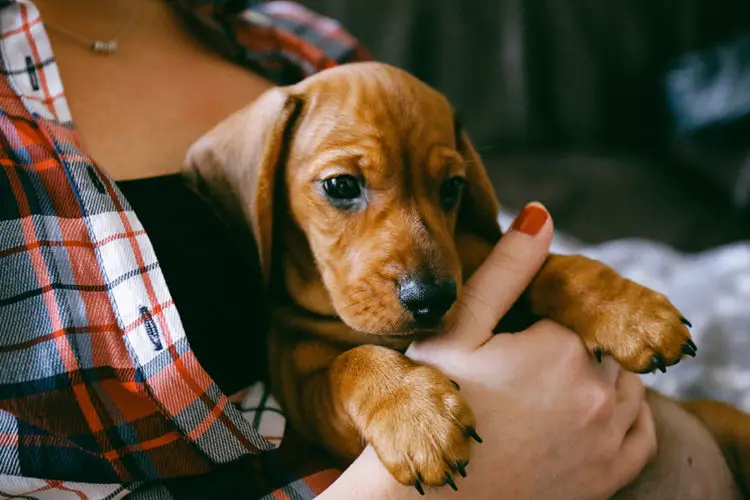A significant debate has been going on regarding the Dachshunds’ front feet and their ‘Queen Anne legs’ and if it is normal or not. The answer lies in the matter of degree. According to breed standards, the front legs of the Dachshund should either face forward or they can be turned out, but very slightly, and there are good health reasons behind it. It is not only related to looks, but it is to make sure that the dachshund is ‘fit for purpose’ when it grows up and the dog is not in any pain or suffering any restrictions in movement in the later part of life. Therefore, it is equally important for dog buyers as it is for those who want to show their dogs.

The reason behind it is that one bone grows faster than the other, which twists the leg, making it bow and the foot turn out. Generally this is a common occurrence in Dachshunds. They are a dwarf breed and tend to have deformed legs. This is also true in the case of many dwarf human beings. If the Queen Anne leg angle is very pronounced in a Dachshund, it may result in severe pain and ultimately require an operation. This is why knowledgeable and responsible breeders do not breed from a dog with very noticeably turned out feet, even if the dog is very cute and appealing.
It is also why Dachshund experts have recommended that even walking the dog can result in all types of issues with the growth plates.
There can be several reasons associated with the front leg deformities in your Dachshund. Some of the common reasons include trauma, elbow misalignment syndrome, osteochondrosis, nutritional deficiency or congenital defects.
Antebrachial Growth Deformities In Dogs
Sometimes the front leg of the dog may continue to grow even after the other one has stopped. This results in one normal sized leg and another irregularly sized one. This is generally known as antebrachial growth deformity, where the bone of the shorter leg may twist and bow or it may overgrow at the elbow. In all these cases, the result is bone misalignment. The tendency of the joint to stop growing is due to a just recessive DNA trait in some dogs. Any owner will notice this breed are good diggers, so they need well arched, broad and big front feet, strong toes and tough pads. Neither the long nor thin ‘hare foot” nor the small and round “terrier foot” are suitable for this purpose. Any dog that has insufficient exercise will have soft pads, and many appear to be flat-footed.
The skin on the front legs needs to be titrated and not wrinkled, which has the risk of being torn when the Dachshund is working out in rough undergrowth. This dog breed may also have incorrect and loose-fitting skin on other parts of the body like dewlap.

Dachshund Foot Problems
This breed are small and lively, and very good hunters. We have a very good sense of smell, and were bred to hunt above and below the ground by burrowing for badgers and gophers. All three types of Dachshund (the shorthaired, long-haired and the wire-haired) have short legs and a long body. Like all the dogs, the feet need to be monitored carefully in order to ensure good health and proper grooming. Their feet are different from other breeds. The front paws are tight and compact, and they have arched toes, and tough thick paw pads. Their paws have five toes: four are used and one can be removed on the front feet. The hind paws are small as compared to the front paws, and they also have rugged paw pads.
Dachshunds are known for certain health problems, which include obesity and spinal disease. However their feet are particularly prone to some issues. A common problem generally found in Dachshunds is dry and cracked paw pads. Even if these dogs have some rugged paw pads, on account of age and walking on hot pavements, there can be painful cracks. The existing pain in full paw pads may become even more painful with obesity. Therefore it is very important that a healthy weight should be maintained for Dachshunds. It is possible to treat dry paws with a moisturizer that has been particularly formulated for dogs and is easily available at pet stores.
Allergies
You may notice your Dachshund chewing or licking its paws obsessively. Generally this is the result of an allergy, even if it is usually considered as grooming behavior. The allergens that may result in this behavior include bacteria, food, fleas and even hay fever.
The vet can perform several tests to find the cause of allergic reaction, which is the key to treatment. If your Dachshund is allergic to certain foods, the food simply needs to be changed, but if it is allergic to bacteria or fleas, treatment can be difficult. Typically anti-histamines are prescribed for treating the itching that results in chewing and licking. Sometimes, steroids like prednisone may also be required for controlling allergies, particularly if it becomes quite severe. However, these are generally used on a short-term basis, due to the side effects associated with the long-term steroid use.
Some other foot problems that are generally found in Dachshunds include problem toenails and interdigital cysts under and between the paw pads. The problem toenails may be the result of a lack of grooming and also caused by allowing the toenails to become very long, which may cause them to tear or rip. It is also a good idea to frequently consult your dog groomer or vet for the maintenance and care of your dog’s toenails. It is very easy for a vet to remove any interdigital cysts by using a needle for aspirating them. However, you should not try to do this yourself.
Genetic Secret Behind the Stubby Legs

The main reason behind the stubby legs in Dachshunds is a gene mutation. This gene can also be found in other short breeds. According to researchers, this single gene affects the growth mechanism at the wrong time during fetal development.
Studies claim that the mutation started sometime after dogs genetically diverged from wolves. The gene is said to be a dominant one. So, dogs with just one copy of the gene can end up having stubby and squat legs. When a certain number of short breed dogs were examined, the results showed that all the squat legged ones have an extra gene at the same site as a protein that promotes growth. Due to this extra gene, the amount of protein becomes overabundant, thereby affecting growth during fetal development. This extra gene has been named as “retrogene”, and it is single-handedly responsible for the squat form of Dachshunds.
Problem Toenails
This is a very common problem among Dachshunds. There can be multiple reasons for this problem. Some are:
- Infrequent and improper clipping
- Allergies
- Onychomycosis or fungal infection that appears on the nail bed
- Nail bed tumors or nail bed cancer, which affects the underlying nerves and veins
- Autoimmune diseases that may cause inflammation or bleeding in the toenails
- Improper nutrition which makes the nails brittle and prone to infections
To assess if your dog is suffering from any problems in the claws, you have to know some of the symptoms. Here are the common ones you can look for:
- Redness
- Swelling
- Brittle nails
- Difficulty in walking
- Discoloration
The treatment and prevention of this problem can be done with the help of a vet. You can make sure your dog has clean nails and clip them when needed. If any symptoms are visible, visit a vet immediately. Also, take proper care of your dog’s diet.
Interdigital Cysts

Another common problem in Dachshunds is interdigital cysts. This affects the toes, and its actual name is the interdigital furuncle. Areas of deep pyoderma develop between the toes, which can be single or multifocal. These lesions can be really painful, causing the dog to limp.
The problem is thought to arise from a serious bacterial infection. Initially, it appears as a single nodule in the webbing between the toes. If not treated in time, these can multiply to form multiple nodules. In the multifocal form, these lesions measure 1 to 2 cm in diameter, appearing red and shiny. If ruptured, a bloody fluid is released.
Chances of recurrence are less when the lesion is formed due to a foreign body like grass or soil. In the case of bacterial infection, these lesions keep coming back. The diagnosis is based on skin biopsy. Lesions are painful, so the dog will definitely be lame on that leg and will be licking the affected area often. If you see any of this happening, go to a vet for a check-up. If an interdigital furuncle is detected then topical biotics are the treatment. In the case of severe multifocal nodules, systemic therapy may be necessary.
For long-term therapy, here are a few things the pet owner should know:
- Avoid electric clipper blades; use scissors instead
- Wash the paws daily with 2% chlorhexidine/2% miconazole shampoo
- Polymyxin B and bacitracin ointment should be applied multiple times daily
- Systemic therapy should be done for at least four weeks
- Dogs having recurrence should be bathed in chronic topical antimicrobial solutions
A dog suffering from an interdigital furuncle needs a lot of care and cleaning on a regular basis. Make sure it gets the required therapy in time, or it can be really painful for the dog.
Patellar Luxation
Dachshunds are known to have problems in the knee also. Patellar luxation is a problem in which the patella (the knee cap) moves out of its actual position. The almond-shaped patella helps the dog with knee extension. When the knee cap displaces from its position on knee extension, it is termed as a luxating patella.
The cause may be genetic, congenital, or traumatic. This problem is common in many short breeds and a few large breeds as well. Limping, unusual sitting posture, sudden loss of support on one leg, etc. are some symptoms. In severe cases, it can lead to osteoarthritis.
If the problem is genetic then the only way to help the dog is to provide important nutrients and exercise. Vitamins C, E, B1, and B6 are some major vitamins you should include in the diet. Iron, calcium, copper, manganese are the minerals the dog requires. If detected at an early stage, this can be easily cured. But in the later stages, the problem turns severe and surgery is needed to relieve the pain.
Looking for a Cute Dachshund Gift?
Check out my outstanding quality coloring book for kids, now available on Amazon:
Famous Floppy The Dachshund goes on vacation around the world!
Color in his adventures in a cute book!
Read the interesting story!
Have a Ton of Fun!


